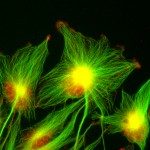Lien vers Pubmed [PMID] – 22325597
Methods Cell Biol. 2012;108:47-71
In recent years, the interest for proteins that exert key functions in vesicular trafficking through their ability to sense or induce positive membrane curvature has expanded. In this chapter, we first present simple protocols to determine whether a protein targets positively curved membranes with liposomes of well-defined size. Next we describe more sophisticated approaches based on the controlled deformation of giant liposomes. These approaches allow visualization and quantification of protein binding to membrane regions of high curvature by real-time fluorescence microscopy. Last we describe several functional assays to measure how membrane curvature controls the activation state of Arf1 via ArfGAP1 or the asymmetric tethering between flat and curved membranes via the golgin GMAP-210.
